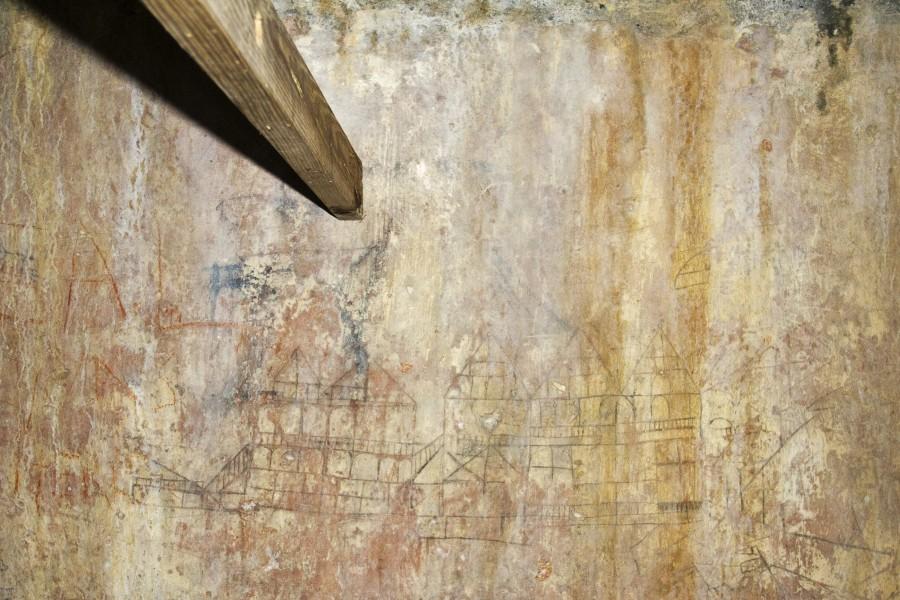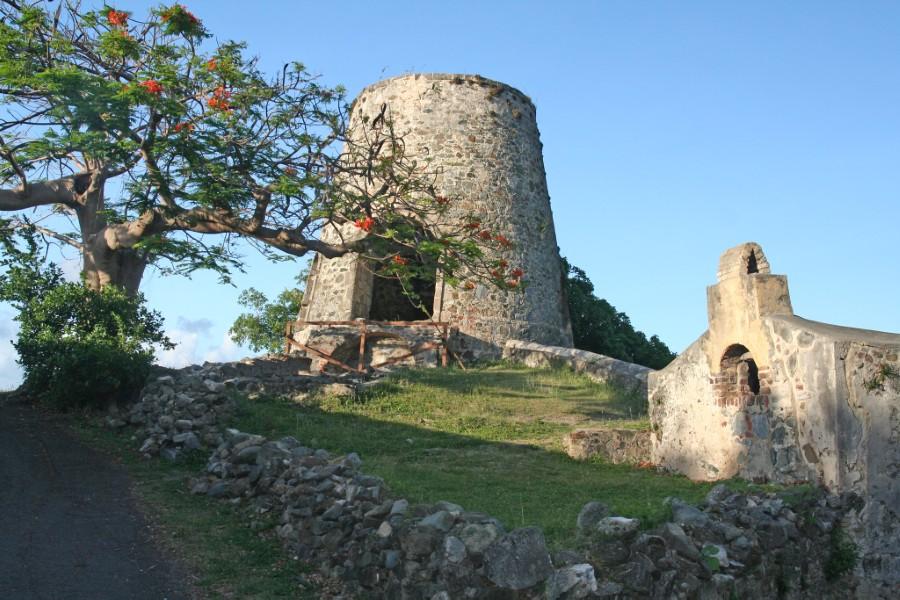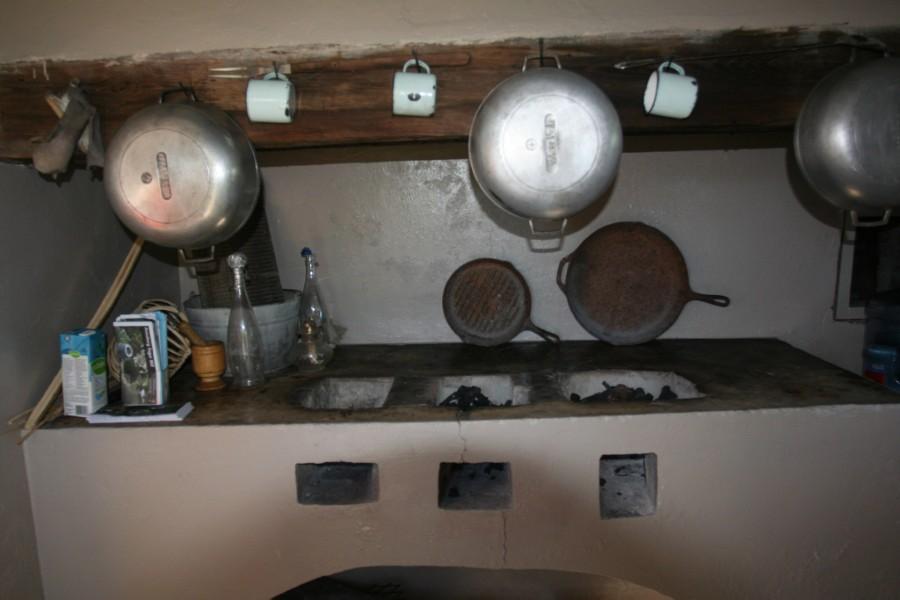The man to give the name Annaberg to the plantation was Solomon Zeeger, a Dutchman from St. Eustatius. Zeeger acquired the plantation in 1758 and named it Annaberg (Anna’s Hill) after his wife, Anna deWindt.

How To Get To The Annaberg Plantation
If you are coming from Cruz Bay via the North Shore Road, proceed to Maho Bay, where the road leaves the shoreline and turns inland towards the right. From here, continue about 1.5 miles, where you will come to an intersection with the Leinster Bay Road that runs along the shoreline.
Turn right when you get to the water’s edge. Go about a quarter mile to the end of the paved road, where you’ll find the parking lot for the Annaberg Sugar Mill.

If you are arriving via Centerline Road, turn north on Route 20 near the Colombo Yogurt stand. Go down the hill and turn right at the first intersection. This will take you to the Leinster Bay shoreline, where you will turn right and proceed to the Annaberg Plantation parking area at the end of the paved road.
The view from Annaberg is spectacular. You can see down into Leinster Bay, the Narrows, the Sir Francis Drake Channel, several of the British Virgin Islands, and forested the mountain valleys of St. John.

Annaberg Plantation Ruins
The slave quarters (called worker’s quarters after Emancipation) barely remain. However, archeologists have uncovered a wealth of artifacts here. There were more than 16 buildings in this area.

These structures were made of daub and wattle. Daub is a type of mortar made of coral, lime, and sand that were fired together and then mixed with molasses and mud. Wattle is a woven structure made of wood from the false coffee bush.
The mortar (daub) was packed into the wattle walls like plaster. The roof was thatched with sugarcane leaves or palm fronds.
This is a brief overview of the ruins you’ll find along the plantation.
Factory – As you walk through the ruins, you will notice the steep hills behind the factory. This entire hillside was planted in sugarcane. The natural vegetation was cut and burned, and the hillsides were terraced using native stone.
The cane was then brought to the fields and planted. Water had to be hauled to the sugarcane plants by hand. When it was time to harvest the cane, the slaves worked 18-20 hours a day. They cut the cane and loaded it onto carts, which were drawn by donkeys to the sugar mill.

A holding cell called the dungeon is located on the lower south side of the estate. Rust stains show where shackles were attached and remains of graffiti still exist.

Horse mill – When the horse mill was being used, horses, oxen, or mules walked around the circular horse mill turning the three crushers. Four slaves were needed to run the animal mill. One drove the animals, two worked the rollers feeding the cane, and one took away the leftover sugarcane pulp called bagasse.
The Windmill – On St. John, only the plantations at Annaberg, Carolina, Denis Bay, Susannaberg, Cathrineberg, and Caneel Bay used windmills. For reference, there were 140 windmills built on St. Croix. The 40-foot-tall Annaberg windmill was built between 1810 and 1830.

The wind-powered blades turned the rollers that crushed the sugarcane. While the horse mill could only crush about 50 cartloads of cane per day, the more efficient windmill could crush 75-100 cartloads. The sugarcane had to be juiced within 24 hours of being harvested to prevent spoilage.
Slaves worked almost around the clock at harvest time. When it was windy, both windmill and horse mill were operated simultaneously. It took about ten slaves to work the windmill. Two of the men fed the bundles of sugarcane back and forth through the cane-crushing rollers.
After the cane stalks were crushed, the juice ran from the crushers down into the boiling room through wooden troughs. The juice then went into the first of five iron pots, where it was boiled. The fire was made in a fire pit and fueled from the outside of the sugar factory walls.

The crushed cane stalks that remained were collected, dried, and taken to a storage shed, the stone columns of which still remain.
The thickened juice was then ladled into the neighboring pot and boiled again to just the right consistency and then ladled into the succeeding pot. This was done, pot after pot, until a brown sugar, called muscovado, was produced.
The workers in the boiling room had to be highly skilled. A mistake in timing would end up in the production of molasses, which was not nearly as valuable as sugar.
The muscovado was then cooled and dried. The finished product was loaded into large wooden barrels called hogsheads containing about 1,000 pounds of sugar each. The barrels were brought to dories and then loaded onto larger vessels bound for Europe.
Rum was produced at the rum still. Sugarcane trash, cane juice drippings, and molasses were all fed into a fermentation cistern. The fermented liquid was then boiled in a copper still over a slow fire.
The alcohol vapors rose up in copper coils that led into the cooling cistern. The cool water of the cistern caused the vapor to condense, and a harsh, raw rum called “kill devil” was formed. More refined rum was produced by aging the kill devil in wooden barrels for several years.

Water was collected and stored in cisterns, which were all connected by aqueducts. Three cisterns are located within the ruins at the mill. The remains of the others are higher up on the hillside.

The Provision Grounds – The Danish colonization of St. John was characterized by the establishment of plantations dedicated to the production of sugar, cotton, and other tropical products. Africans, forced into slavery, provided the labor for these plantations. Under such a system, the slave owner had to decide how these slaves would be fed.
The solution on St. John was to have slaves produce their own food on plots called provision grounds located on the less productive areas of the plantation.
Because the provision grounds were unsupervised, the slaves were able to gather and interact out of sight of their masters. Although often forbidden, slaves from different plantations could meet on the more remote provision grounds.
On these occasions, cultural traditions could be passed on, the news could be disseminated, and conspiracies involving escape and resistance plans could be discussed.
Slaves often worked together on their plots and shared the harvest. Those who were strong and healthy supported the old, weak, or infirm. On some plantations, the slaves were able to produce a surplus of food, charcoal, or crafts, and a system of exchange developed along with an underground economy.
This even provided some slaves with enough money to buy their freedom. Moreover, the tradition of an agriculturally based society enabled the slaves to survive on St. John after the failure of the sugar industry and the end of slavery.

Ajax Peak – On the Annaberg plantation, the provision grounds were located on the hillside to the south of the estate. This area was chosen because it was only marginally suitable for sugar production.
After the St. John slave revolt of 1733, planters were apprehensive about the possibility of another revolt. As a result, they tried to keep the slaves from different plantations from communicating with each other. On Annaberg, the hillside to the south that was chosen as the provision grounds area was fairly close to a provision grounds of a neighboring located on the opposite slope of the same hillside.
To prevent slaves from the two estates from meeting with each other, a slave named Ajax was posted on the top of the hill to stand guard. The name of that hilltop to this day is “Ajax Peak.”
Cookhouse – The cookhouse at Annaberg was built in the early 20th Century by Carl Emanuel Francis. Food was baked in iron pots called coal pots. Charcoal was placed underneath the coal pot, which was then covered with galvanized steel. Additional charcoal could be placed on top.
Herbs for medicine and cooking were gathered from the bush or grown in the garden. Maran bush was used for brooms and pot scrubbing a (readily available natural material – it scrubbed and deodorized as well). Sea fans were used as whisks and sifters. Baskets were made from hoop vine.
Today, Miss Olivia bakes dumb bread in the traditional method as a cultural demonstration.


National Park interpreters and volunteers give demonstrations and discussions on the local culture of the time, including baking, basket weaving, folk life, and agricultural techniques. For more information, contact the VI National Park online at www.nps.gov/viis or call (340) 776-8811.
History of The Annaberg Plantation
Before the arrival of the Europeans, Annaberg was heavily forested with tall tropical hardwoods, which created a shady canopy, a park-like setting where one could walk easily between the trees. After European colonization, almost all of these trees were cut down to establish plantations. Today what we see is all second and third growth.
In 1718, the island of St. John was claimed by the nation of Denmark, and settlement began that year. What was later to be named the Annaberg plantation was first taken up by a French refugee, Isaac Constantine, in 1721. It took almost 10 years to clear the hills, establish the sugar-making infrastructure and get the first crop put in the ground.
In 1733, the slaves on St. John revolted, and most of the buildings at Annaberg were destroyed or heavily damaged.
In 1796, Annaberg was purchased by James Murphy, a wealthy St. Thomas merchant, ship owner, and slave trader. In addition to Annaberg, Murphy bought five other plantations that were contiguous with Annaberg. The consolidated lands were called Annaberg, which became the largest and most successful plantation on St. John.
Several factors combined, which in the end, resulted in the total demise of sugar as an industry in St. John. To begin with, the planting conditions on St. John were marginal due to the steep terrain, rocky soil, and low rainfall.
In addition, depletion of nutrients in the soil after years of continuous sugar planting without soil replenishment and persistent erosion that could not be completely controlled by terracing lead to lower and lower crop yields. The price of sugar declined with increased competition from other areas that were better suited to produce sugar.
Sugar production in those days was extremely labor intensive and even more so on St. John due to naturally poor conditions and its remote location. In fact, St. John’s sugar production was only economically feasible because the labor force was enslaved.
Emancipation in the British West Indies and Grand Maroonage (Escape by Sea) on St. John. Slavery was abolished in the British Virgin Islands in 1840 but continued in the Danish West Indies until 1848.
Between those years, the proximity of St. John to Tortola provided slaves on St. John with a unique opportunity to achieve their freedom. Tortola lay just across the Sir Francis Drake Channel. From Annaberg, this distance was only a little more than one mile.

Tortola lies only about a mile away across the Sir Francis Drake Channel
In May of 1840, eleven slaves from the Annaberg Plantation fled to Tortola. This was the first major slave escape occurring during that period.
After emancipation, planters on St. John tried to keep their slaves working on the plantation by enforcing labor laws designed to perpetuate the plantation system. Slaves, now known as workers, could not leave the plantations. Wages were kept artificially low and often were paid in the form of goods called an allowance.
Disgruntled workers began to offer resistance to the unjust labor laws. They brought their grievances to the Danish authorities, organized strikes and work stoppages, and often ran away to Tortola or St. Thomas.
After emancipation, slavery continued on St. John in practice, if not in theory. But worker resistance and the unfavorable economics of sugar production on St. John, more than any legal proclamations, eventually brought about the end of this unofficial system of slavery.
In 1867, a major hurricane followed by an earthquake and a tsunami led to the abandonment of Annaberg by the owner. Two hundred laborers on the Annaberg and Leinster Bay Plantations were left to fend for themselves. They asked the authorities permission to stay on and work the plantations on their own, but they were refused.
After the twin disasters of 1867, George Francis, a slave born on the plantation, who became foreman of the estate after emancipation, was able to purchase the once prosperous Annaberg estate for a fraction of what it was once worth.
In 1899 the estate passed to his son, Carl Francis, who set out to restore the estate that had further declined over the years.
Mr. Francis raised cattle on the estate from the early 1900s until its sale to Herman Creque in 1935. He built a house on the site of the horse mill, which was rebuilt after the great hurricane in 1924. The family survived by taking refuge in the windmill, which, although it had no roof, provided the necessary protection. (St. John did not experience another major hurricane until Hurricane Hugo in 1989.)
In 1935, Carl Francis sold Annaberg to Mr. Herman Creque, who left the estate to his wife, Emily. In 1955, Annaberg was sold to the Rockefeller-controlled Jackson Hole Preserve Inc. and donated to the National Park. When the U.S Virgin Islands National Park acquired the land in the 1950s, they dismantled the house. The cookhouse is all that remains.
The Virgin Islands National Park Service has prepared a self-guided tour of the historic Annaberg Plantation Ruins. The walk through this partially restored old sugar factory provides a great deal of insight into the history and culture of St. John during the plantation and post-emancipation eras.
